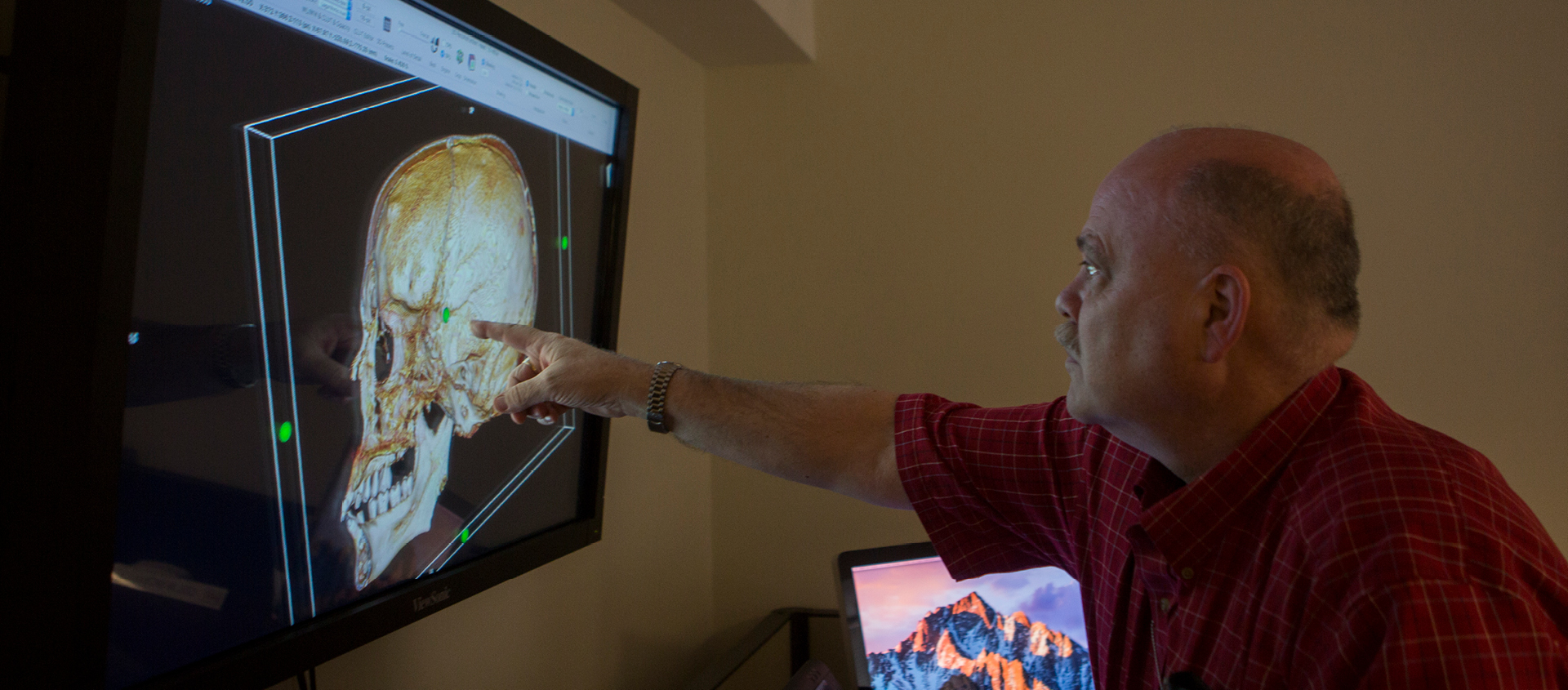Helping Give Kids Their Names Back
Anyone looking at the 3-D image on the large computer screen would see a human skull. Dr. David Hunt sees something else altogether: a boy, probably no older than 16 or 17 when he was killed, most likely in the mid-1980s. The bones on his face are telling him about the shape of his eyes, his face and neck, his ancestry.
Using the insight from Dr. Hunt, forensic artist Colin McNally begins rebuilding the child’s face on his computer using “digital clay.” He sculpts tissue on the skull first, then muscle, then the nose, letting the bones guide him. McNally feels an enormous sense of responsibility. Family members may still be looking for him, haunted by his disappearance. McNally wants to help get his name back.


Dr. Hunt, or “Dr. Dave” as he is affectionately called, has been an invaluable resource, and beloved mentor, at the National Center for Missing & Exploited Children since he began volunteering his time in 1997. Using his vast experience as a physical and forensic anthropologist and archeologist at the Smithsonian’s National Museum of Natural History, Dr. Hunt has collaborated with NCMEC on more than 200 cases of unidentified deceased children, helping give children their names back and making an immeasurable impact on people’s lives.
“It’s one thing to get a medical examiner’s report, but we don’t know what that child looked like,” said McNally, supervisor of NCMEC’s Forensic Imaging Unit, whose work includes skull reconstructions. “But when Dr. Hunt looks at a skull, he’s already seeing unique aspects of that child’s face. His knowledge allows us to have an amazing resource when creating these children’s faces, getting them out to the public and hopefully getting an identification.”
For his more than two decades of work helping families of missing children and law enforcement, Dr. Hunt was recently honored with the Attorney General’s Citizen Volunteer Service Award, which is awarded each year to members of the public for their outstanding volunteer contributions toward the Justice Department’s mission. NCMEC helped nominate him for the prestigious award.
Always humble, Dr. Hunt explained in an Office on Violence Against Women podcast, called Patchwork, why he’s so invested in helping the Alexandria, Virginia-based nonprofit, the leading child safety organization in the country and just across the Potomac River from where he works.
“It’s terrible in the sense that the work I do often leads to the family finding out that their child has passed,” Dr. Hunt said. “It also gives the family some closure rather than always wondering what happened. It is something that I can do that I can return back my training to society and the public good.”
Joe Mullins, a senior forensic artist who’s been working with Dr. Hunt since he came to NCMEC, said he simply couldn’t do his job without him. Every time the forensic anthropologist stops by to help, Mullins learns something new, which he then passes on to his own students. Most importantly, Dr. Hunt can look at a skull and see what is unique about that child, or, as he explains to Mullins, “what makes you you.”

Dr. Hunt’s collaboration with NCMEC began as many things do in life: by chance. In 1999, a Las Vegas detective, frustrated he could not solve the murder of an unidentified young child found murdered on Nov. 2, 1996, turned to NCMEC’s Forensic Imaging Unit for help. Glenn Miller, a retired Fairfax County police detective, was in charge of the unit, which at the time was focused on creating age progressions of long-term missing children. He wasn’t sure they could help, but always willing to try, Miller told the detective to send him what he had.
Astonished when he opened the package, Miller asked one of his forensic artists, Steve Loftin, to attempt a skull reconstruction. An intern at the time could see Loftin was struggling with the new challenge. She happened to be taking a class with Dr. Hunt and told her instructor about the dilemma. Dr. Hunt showed up at NCMEC to see if he could help. And that he did.
Detectives had dubbed the victim “Tower Jane Doe” after the child’s remains were found in an area filled with electrical towers. But when Dr. Hunt examined the remains, he determined the child was actually a boy, so NCMEC created a computer composite of “Tower John Doe” and what he might have looked like.
The story and composite aired on the popular television show, America’s Most Wanted, starring John Walsh, a co-founder of NCMEC, and a tip came in saying the composite looked a lot like a 14-year-old boy named Michael Rainey. Dental records confirmed his identity. Dr. Hunt had helped Michael get his name back and a family get the answers they sought – right out of the box. He’s been helping NCMEC ever since.
As invaluable as his help is with cases, NCMEC’s forensic artists say he’s been equally as generous with his time teaching them what he has learned. He’s not only trained NCMEC’s employees, but the next generation as well. His presence at NCMEC always draws a clutch of forensic artists and interns eager to soak up his knowledge.
“It’s captivating,” said Mullins. “How often do you get to sit down with a forensic anthropologist holding up a skull and telling you what that child looked like? It’s still amazing the things that he can do. I’m in awe of my friend Dr. Dave. He does it because it’s the right thing to do.”
